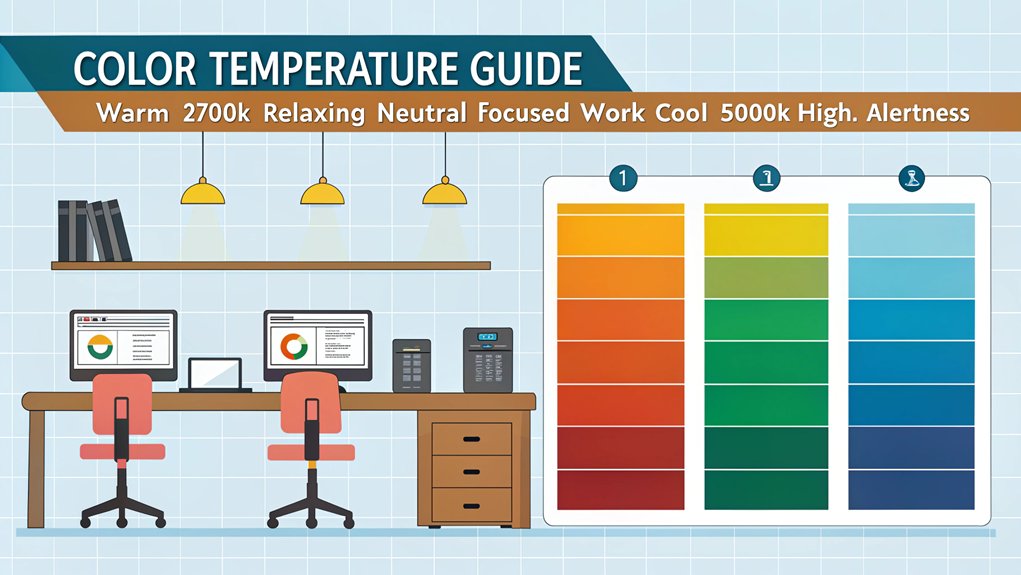When it comes to optimizing your computer workspace, understanding desk lamp brightness levels is key. The right illumination can greatly influence your productivity and comfort. You need to take into account not just lumens but also color temperatures and adjustability features. This blend creates an environment conducive to focus and creativity. But how do you determine the ideal setup for your specific tasks? The answer lies in careful analysis of your workspace dynamics.
Key Takeaways
- Aim for 450-500 lumens for general office tasks and 800-1200 lumens for focused work like studying or drafting.
- Lux levels should range from 200-750 for office work, ensuring sufficient light on the work surface.
- Use lamps with color temperatures between 4000K to 5500K to boost focus and mimic natural daylight.
- Position lamps laterally to minimize shadows and ensure optimal visibility for your dominant hand.
- Opt for energy-efficient LED for adjustable desk lamp brightness levels and features like motion sensors for a sustainable workspace.
Importance of Desk Lamp Brightness Levels in Home Office Lighting
When you’re setting up your home office, the brightness of your lighting is crucial, as it directly affects your productivity and comfort.
The right brightness impacts your workspace ambiance, reducing eye strain and enhancing focus. If you’ve ever experienced headaches from harsh lighting, you know that ideal levels not only prevent discomfort but also elevate your mood and engagement. Adjustable lamps can cater to various tasks, improving efficiency by ensuring clarity while you work. Proper lighting notably influences your mood and energy levels while working, facilitating better visibility for tasks and paperwork. Additionally, proper lighting distance is vital to maintain a balanced and effective illumination setup.
The right brightness enhances your workspace, minimizes eye strain, and boosts your mood and focus.
Consider color temperature; cool light promotes alertness, while warm light can induce relaxation.
Integrating natural light is also essential, as it enriches your environment and reduces reliance on artificial sources.
Ultimately, a thoughtful lighting plan fosters a customized space that energizes your productivity.
Measuring Lumens and Lux for Effective Illumination

Finding the right brightness for your workspace involves understanding key measurements like lumens and lux. Lumens quantify the total light emitted by a source, while lux measures how that light impacts a surface. For effective lumen calculation, remember: higher tasks often require more lumens, ranging from 800 to 1200. Lux measurement in your workspace should typically stay between 200 to 750 for general tasks. Here’s a quick reference table to guide you:
| Task Type | Required Lumens | Required Lux |
|---|---|---|
| General Office Work | 450-500 | 200-750 |
| Studying | 800-1200 | 375-1500 |
| Drafting | 800-1200 | 1000-1500 |
| Reading/Writing | 450-500 | 300-500 |
Light Output Ratio indicates the efficiency of your desk lamp in providing adequate brightness while maintaining energy use. LED lamps are an excellent choice as they provide more lumens while consuming less energy. Adjusting your desk lamp brightness levels can optimize your workspace for productivity.
Ideal Color Temperatures for Productivity

Understanding the ideal color temperature for your workspace is essential in cultivating productivity and focus. Typically, color temperatures between 3500K and 5500K are best for maintaining alertness. Aim for 4000K to 4500K; this neutral light supports general tasks without causing eye strain. Cooler temperatures around 5000K emulate natural daylight, considerably enhancing mental activity and reducing fatigue, thereby amplifying your productivity impact. Bright lighting encourages alertness and productivity in work environments, so be wary of options below 3500K, which encourage relaxation instead of focus, and those exceeding 5500K, as they can lead to eye strain. Additionally, understanding LED color temperature is crucial for selecting the most effective lighting solutions for your space.
Task Lighting and Adjustability Features

When it comes to task lighting, adjustable arms play an essential role in directing light precisely where you need it. By ensuring your desk lamp has an ideal lumen range, you enhance your workspace’s functionality, reducing eye strain while maximizing visibility. This tailored approach not only improves focus but also elevates your overall productivity. Additionally, maintaining a recommended light level of 500 to 1000 lumens ensures sufficient brightness for tasks like reading and writing. Investing in an energy-efficient LED lamp can further contribute to reducing overall energy consumption while providing high-quality lighting for your workspace.
Importance of Adjustable Arms
Adjustable arms in desk lamps play an essential role in optimizing task lighting, ensuring you can direct light exactly where needed.
With features like goosenecks and pivoting heads, these lamps offer adjustable flexibility that lets you achieve focused illumination tailored to your specific tasks. Whether you’re reading, writing, or working on computer applications, positioning light precisely can greatly enhance your visibility and reduce eye strain. This is further supported by the lamp’s fully adjustable 30 boom arm feature, allowing for precise positioning of the light source. Additionally, good lighting can enhance productivity by creating a more comfortable working environment.
By minimizing shadows and glare, adjustable arms allow you to create the ideal lighting environment that promotes productivity. Plus, their compact design saves desk space while maintaining versatility.
Embracing the benefits of adjustable arms can transform your workspace into a more efficient, comfortable setting tailored to your unique work needs.
Optimal Lumen Range
Selecting the right lumen level for your desk lamp is essential not only for enhancing task efficiency but also for ensuring your comfort while working.
A lumen comparison reveals that for basic desk tasks, 400 to 470 lumens suffice, while detailed work like studying demands between 800 to 1,200 lumens. Understanding these workspace requirements allows you to select a suitable lumen range tailored to your activities. Desk lamps are designed to reduce glare on work surfaces, ensuring a more comfortable experience during long hours of use.
Adjustable desk lamp brightness levels and color temperature provide flexibility, adapting to various lighting needs efficiently. Higher lumens typically indicate a brighter light, which can further aid in reducing eye strain during extended periods of work.
Choosing energy-efficient LEDs, with output options from 450 to 1,000 lumens, further enhances comfort, reduces eye strain, and minimizes glare.
Such thoughtful adjustments enhance your workspace, promoting productivity and well-being.
Optimal Desk Lamp Placement Techniques

Proper placement of your desk lamp is essential for maximizing productivity and minimizing eye strain. To achieve ideal lamp orientation, consider these techniques:
| Placement Technique | Key Benefits | Shadow Management |
|---|---|---|
| Lateral Placement | Reduces shadows on dominant hand | Guarantees clear workspace visibility |
| Vertical Height | Avoids glare | Enhances comfort during use |
| Distance from Workspace | Maintains broad illumination | Prevents obstructed lines of sight |
| Monitor Alignment | Prevents screen glare | Supports focused task lighting |
Using adjustable height and arm features allows you to customize the lamp directly to your needs. Strategically positioning your desk lamp enhances focus while managing shadows, ultimately creating an innovative workspace that promotes efficiency. Additionally, proper light placement is crucial for maximizing light source efficiency in your workspace. Task lighting offers specific illumination tailored to your activities, ensuring that you have sufficient brightness for different tasks.
Energy Efficiency and Additional Features in Desk Lamps

When choosing a desk lamp, understanding energy efficiency and additional features can greatly enhance your workspace.
Opt for eco-friendly LED lamps; they deliver impressive energy savings, consuming much less energy than traditional bulbs. With a lifespan of up to 50,000 hours, you’ll replace them less frequently, boosting cost-effectiveness over time. Additionally, investing in LED lamps provides long-lasting lighting, which reduces waste and maintenance costs. Proper desk lighting is essential for enhancing visibility and reducing eye strain during extended periods of computer work.
Choose LED lamps for remarkable energy savings and longevity, ensuring cost-effectiveness and reduced bulb replacements over time.
Modern lamps often come equipped with adjustable arms, dimming capabilities, and smart controls, allowing for optimal personalization. Consider options with motion sensors that respond to your presence, ensuring energy isn’t wasted when you’re away.
These innovative designs not only improve your productivity by reducing eye strain but also contribute to a sustainable environment. Embrace these features for a brighter, more efficient workspace.
Frequently Asked Questions
How Can I Reduce Eye Strain While Using Desk Lamps?
To reduce eye strain, choose a desk lamp with adjustable brightness and low blue light emissions. This allows you to tailor illumination to your needs, minimizing fatigue and creating a comfortable, focused workspace for innovation.
What Is the Best Lamp Style for Small Desks?
For small desks, consider clip-on lamps for space-saving efficiency, adjustable height for personalized comfort, and features that enhance functionality. Explore innovative designs that blend aesthetics with practicality, transforming your workspace into a hub of productivity.
Can Desk Lamp Brightness Levels Affect Mood?
Yes, desk lamp brightness levels definitely affects mood. You’ll find that different brightness effects influence your emotions and productivity. Optimizing mood lighting can create an inspiring workspace, boosting energy and enhancing focus throughout your day.
Is There a Recommended Light Angle for Desk Lamps?
Think of a beam of sunlight slicing through the morning haze; that’s the light direction you want. Position your lamp about 15–20 inches high, angled carefully to highlight your workspace without blinding you.
How Often Should I Replace My Desk Lamp?
You should replace your desk lamp based on bulb types: halogen bulbs last about a year while LEDs can endure up to 30 years. Consider lamp lifespan to maximize efficiency and minimize costs effectively.
Conclusion
In closing, understanding desk lamp brightness levels is like finding the secret key to a well-lit productivity heaven. By carefully selecting lumens and color temperatures while considering adjustability, you can transform your workspace into an oasis of focus and creativity. Remember to position your lamp effectively and prioritize energy-efficient options, ensuring you not only illuminate your tasks but also enhance your overall well-being. With the right lighting, you’re not just working—you’re thriving in your home office!

I am a retired software engineer with experience in a multitude of areas including managing AWS and VMWare development environments. I bought a relative a mini-PC a year ago and have become passionate about the technology and its potential to change how we deploy software.

